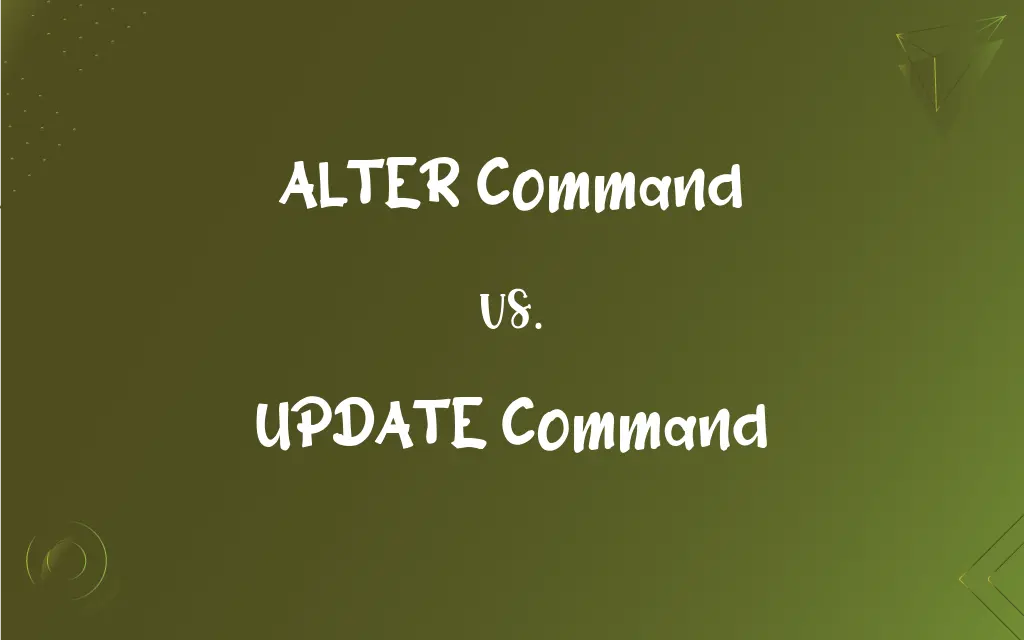ALTER Command vs. UPDATE Command: What's the Difference?
Edited by Aimie Carlson || By Janet White || Published on February 29, 2024
ALTER Command modifies the structure of a database table, while UPDATE Command changes the data within a table.

Key Differences
The ALTER Command is used in database management systems to modify the structure of an existing table, such as adding, deleting, or modifying columns. In contrast, the UPDATE Command is employed to modify existing data within the table. Both commands are crucial for maintaining and manipulating databases but serve distinct functions.
ALTER Command deals with the schema and structure of a database table, the UPDATE Command focuses on the content within the rows of the table. ALTER Command might change the table's design or its constraints, whereas UPDATE Command is used to change the values stored in the table's rows.
ALTER Command is often used less frequently than UPDATE Command, as structural changes are less common than data updates. ALTER Command can impact the database design, which is usually stable, whereas UPDATE Command is part of regular database operations, altering data as required.
The execution of the ALTER Command can be more complex and may require more caution, as it changes the table's architecture. On the other hand, UPDATE Command, although also powerful, typically involves simpler operations related to modifying data values.
The ALTER Command is essential for database design and modification, while the UPDATE Command is crucial for data management. Both commands are integral to database administration but function in fundamentally different aspects of database operation.
ADVERTISEMENT
Comparison Chart
Primary Function
Modifies table structure (e.g., adding/removing columns).
Modifies existing data within table rows.
Frequency of Use
Used less frequently, for structural changes.
Used regularly for data updates.
Impact
Affects the database schema and design.
Affects the data stored in the database.
Complexity
Can be complex, requires careful planning.
Relatively simpler, focused on data modification.
Typical Use Case
Adding a new column to a table.
Changing the value of a specific field in records.
ADVERTISEMENT
ALTER Command and UPDATE Command Definitions
ALTER Command
ALTER Command is used to modify the structure of a database table.
ALTER TABLE Students ADD COLUMN Grade INT;
UPDATE Command
It allows for changing multiple records based on specific conditions.
UPDATE Products SET Price = Price * 1.1 WHERE Category = 'Electronics';
ALTER Command
ALTER Command can rename tables or columns within the database.
ALTER TABLE Customers RENAME COLUMN CustName TO CustomerName;
UPDATE Command
UPDATE Command can be used to correct data errors in individual rows.
UPDATE Orders SET OrderDate = '2024-01-15' WHERE OrderID = 12345;
ALTER Command
It enables the modification of table constraints like adding a foreign key.
ALTER TABLE Orders ADD CONSTRAINT FK_Customer FOREIGN KEY (CustomerID) REFERENCES Customers(ID);
UPDATE Command
It enables batch updating of records for efficient data management.
UPDATE Students SET Status = 'Graduated' WHERE GraduationYear = 2024;
ALTER Command
It allows for the addition, deletion, or modification of columns in a table.
ALTER TABLE Employees DROP COLUMN HireDate;
UPDATE Command
UPDATE Command is used to modify existing records in a database table.
UPDATE Employees SET Salary = 50000 WHERE EmployeeID = 1;
ALTER Command
ALTER Command can also be used to change data types of existing columns.
ALTER TABLE Orders ALTER COLUMN Quantity TYPE INT;
UPDATE Command
UPDATE Command is essential for maintaining data accuracy and relevance.
UPDATE Accounts SET AccountStatus = 'Inactive' WHERE LastActivityDate < '2023-01-01';
FAQs
What does ALTER Command do in a database?
It modifies the structure of a database table, such as adding or removing columns.
Is it possible to undo an UPDATE Command?
Only if you have a backup or log of the previous state; otherwise, it's challenging.
Does UPDATE Command affect the table structure?
No, it only changes the data within the table, not the structure.
Does ALTER Command affect the data already in the table?
It can, especially if columns are removed or data types are changed.
Is ALTER Command commonly used?
It's used less frequently than UPDATE, typically for structural changes.
Can UPDATE Command be used to update all rows in a table?
Yes, by not specifying a WHERE clause, it can update all rows.
Can UPDATE Command change multiple rows at once?
Yes, it can update multiple rows based on specified conditions.
Can ALTER Command rename a table?
Yes, it can rename tables as well as columns.
What is the primary use of the UPDATE Command?
It's used to modify existing data within table rows.
Can ALTER Command add a foreign key to a table?
Yes, it can add various constraints, including foreign keys.
What precautions should be taken when using ALTER Command?
Back up data and understand the impact on the overall database schema.
Can ALTER Command change data types of columns?
Yes, it can change the data types of existing columns in a table.
Is ALTER Command reversible?
Yes, but reversing it might require another ALTER Command and careful planning.
Are ALTER and UPDATE Commands specific to certain database systems?
They are common across most relational database management systems.
How does UPDATE Command handle NULL values?
It can set fields to NULL or update NULL values based on conditions.
What's the risk of using UPDATE Command without a WHERE clause?
It can unintentionally update all rows in the table, leading to data issues.
Is it possible to add a default value to a column using ALTER Command?
Yes, ALTER can set default values for columns.
Can ALTER Command merge two tables?
No, it can't merge tables; it's used for modifying existing table structures.
Can UPDATE Command be used for error correction in data?
Yes, it's often used to correct or update incorrect or outdated data.
Can ALTER Command disable constraints on a table?
Yes, it can be used to disable or modify constraints.
About Author
Written by
Janet WhiteJanet White has been an esteemed writer and blogger for Difference Wiki. Holding a Master's degree in Science and Medical Journalism from the prestigious Boston University, she has consistently demonstrated her expertise and passion for her field. When she's not immersed in her work, Janet relishes her time exercising, delving into a good book, and cherishing moments with friends and family.
Edited by
Aimie CarlsonAimie Carlson, holding a master's degree in English literature, is a fervent English language enthusiast. She lends her writing talents to Difference Wiki, a prominent website that specializes in comparisons, offering readers insightful analyses that both captivate and inform.































































